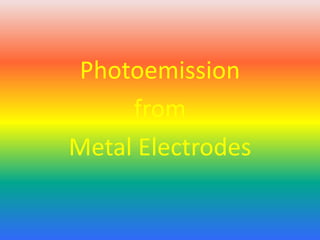Photoemission from Metal Electrodes
•Download as PPTX, PDF•
0 likes•561 views
Photoemission from Metal Electrodes
Report
Share
Report
Share

Recommended
More Related Content
What's hot
What's hot (20)
Cyclic Voltammetry: Principle, Instrumentation & Applications

Cyclic Voltammetry: Principle, Instrumentation & Applications
Similar to Photoemission from Metal Electrodes
Similar to Photoemission from Metal Electrodes (20)
Recently uploaded
https://app.box.com/s/7hlvjxjalkrik7fb082xx3jk7xd7liz3TỔNG ÔN TẬP THI VÀO LỚP 10 MÔN TIẾNG ANH NĂM HỌC 2023 - 2024 CÓ ĐÁP ÁN (NGỮ Â...

TỔNG ÔN TẬP THI VÀO LỚP 10 MÔN TIẾNG ANH NĂM HỌC 2023 - 2024 CÓ ĐÁP ÁN (NGỮ Â...Nguyen Thanh Tu Collection
https://app.box.com/s/x7vf0j7xaxl2hlczxm3ny497y4yto33i80 ĐỀ THI THỬ TUYỂN SINH TIẾNG ANH VÀO 10 SỞ GD – ĐT THÀNH PHỐ HỒ CHÍ MINH NĂ...

80 ĐỀ THI THỬ TUYỂN SINH TIẾNG ANH VÀO 10 SỞ GD – ĐT THÀNH PHỐ HỒ CHÍ MINH NĂ...Nguyen Thanh Tu Collection
Recently uploaded (20)
TỔNG ÔN TẬP THI VÀO LỚP 10 MÔN TIẾNG ANH NĂM HỌC 2023 - 2024 CÓ ĐÁP ÁN (NGỮ Â...

TỔNG ÔN TẬP THI VÀO LỚP 10 MÔN TIẾNG ANH NĂM HỌC 2023 - 2024 CÓ ĐÁP ÁN (NGỮ Â...
Micro-Scholarship, What it is, How can it help me.pdf

Micro-Scholarship, What it is, How can it help me.pdf
HMCS Vancouver Pre-Deployment Brief - May 2024 (Web Version).pptx

HMCS Vancouver Pre-Deployment Brief - May 2024 (Web Version).pptx
ICT role in 21st century education and it's challenges.

ICT role in 21st century education and it's challenges.
NO1 Top Black Magic Specialist In Lahore Black magic In Pakistan Kala Ilam Ex...

NO1 Top Black Magic Specialist In Lahore Black magic In Pakistan Kala Ilam Ex...
80 ĐỀ THI THỬ TUYỂN SINH TIẾNG ANH VÀO 10 SỞ GD – ĐT THÀNH PHỐ HỒ CHÍ MINH NĂ...

80 ĐỀ THI THỬ TUYỂN SINH TIẾNG ANH VÀO 10 SỞ GD – ĐT THÀNH PHỐ HỒ CHÍ MINH NĂ...
General Principles of Intellectual Property: Concepts of Intellectual Proper...

General Principles of Intellectual Property: Concepts of Intellectual Proper...
UGC NET Paper 1 Mathematical Reasoning & Aptitude.pdf

UGC NET Paper 1 Mathematical Reasoning & Aptitude.pdf
Exploring_the_Narrative_Style_of_Amitav_Ghoshs_Gun_Island.pptx

Exploring_the_Narrative_Style_of_Amitav_Ghoshs_Gun_Island.pptx
ICT Role in 21st Century Education & its Challenges.pptx

ICT Role in 21st Century Education & its Challenges.pptx
Interdisciplinary_Insights_Data_Collection_Methods.pptx

Interdisciplinary_Insights_Data_Collection_Methods.pptx
Photoemission from Metal Electrodes
- 1. Photoemission from Metal Electrodes
- 2. This topic deals with the emission of electrons from electrodes on exposure to light. When a metal electrode is illuminated the cathodic currents are stimulated. These cathodic currents are stimulated by the presence of electron scavengers.
- 4. These electrons travel a certain distance before becoming solvated
- 5. If an electron scavenger is present these solvated electrons may react with it irreversibly, then the cathode current is enhanced. If no scavenger is present these electrons will return to the electrode, then the cathode current is small(since the net charge transfer from the electrode is small).
- 7. Thus there is a red-limit wavelength above which photoejection is improbable.
- 8. Fermi level depends on electrode potential, this limit shifts to shorter wavelengths as potential becomes more positive. Hence, for a monochromatic radiation, there is a threshold potential for photoemission and the emission becomes more probable at more negative potentials.
- 9. Experimental section: Earlier techniques: Irradiation of a DME by chopped light from low -, medium -, and high– pressure mercury lamps. Pulse polarographic monitoring circuitry synchronized to the light chopper was used for measurement of photocurrent. The time scale of a photoemission experiment is inherently very short. The diffusion time for return of the ejected electrons is of the order of 100 ns, hence we use this technique to study study very fast electrode processes. Because we cannot realize this potential with low frequency chopping techniques, the flash illumination techniques are developed.
- 10. Flash illumination techniques: Light is supplied to a continuously renewed mercury pool electrode by a Q-switched, frequency –doubled ruby laser with a pulse width of ~ 15 ns . The electrode is set initially at any desired potential, whose response was very slow enough that the electrode’s reaction to the flash can be monitored as a coulostatic transient, ΔE (measured with respect to the initial potential) vs. time. The difference in charge with respect to the initial condition is straightforwardly related to ΔE by: Δq = Cd x ΔE ->where Cd is the differential capacitance of the interface ->as ΔE is only a few millivolts, Cd can be treated as a constant to a given experiment Useful information can be obtained for times as short as a few tens of ns after the flash.
- 11. Applications: The solution chemistry that can be studied by photoemission is largely related to solvated electrons.(This is same as in radiolysis, although the photoemission technique avoids extensive radiolytic damage to the solution components) For electrochemistry, there is a very useful ability to generate near the electrodes, radicals, and other intermediates of electrochemical interest/importance. Purely electrochemical experiments often cannot often provide insight into electrode processes that can be found in this manner. (Ex: processes in which Hradical is involved, it is difficult to isolate the electrochemistry of H radical within the whole discharge process)
- 12. Jai Sai Ram Any Questions
- 13. Thank You